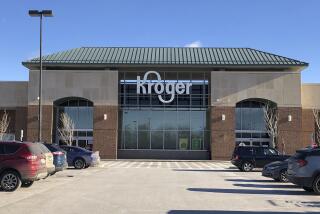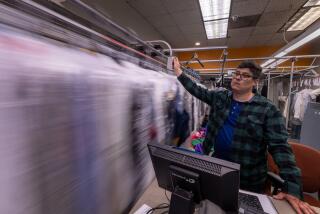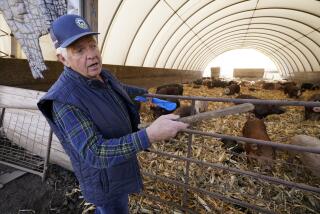‘Sky Shelves’ Can Be Lethal for Shoppers
Few of the millions of shoppers who each day crowd into the retail canyons of big discounters such as Home Depot and Wal-Mart expect to be crushed in an avalanche of merchandise.
But that’s exactly what happened to Mary Penturff.
The 79-year-old Santa Monica woman was looking for lattice to stake her morning glories in November at a Los Angeles Home Depot when a 19-year-old forklift operator accidentally tipped a load of lumber stacked several feet above her. She was crushed to death in front of her horrified daughter.
“You expect to die or get injured if you go to war or if you speed on the freeway,” said the daughter, Rebecca Hamilton. “The last thing you expect when you enter your neighborhood store is that you won’t come out alive.”
Penturff’s accident was just one of thousands of injuries and deaths involving shoppers that resulted from falling merchandise in warehouse-style stores, according to a Times examination of court records from around the country. The incidents have been piling up for at least 15 years, since boxes of Final Touch fabric softener toppled from a shelf at a Sam’s Club store near Tulsa, Okla., in 1985, killing a woman who was shopping for cleaning supplies.
Despite numerous lawsuits and millions of dollars in jury awards and settlements against various discount retailers and warehouse superstores, the toll continues to mount. Only last month, a 41-year-old Connecticut man was killed at his neighborhood Home Depot when a 2,000-pound pallet of landscaping timbers fell and pinned him to the ground.
The mushrooming of retail superstores--where forklifts prowl aisles, stacking pallets of merchandise from floor to ceiling--has brought lower prices and convenience to cities and small towns across America. But thousands of consumers who have ventured into these retail centers to run routine errands have encountered tragedy instead.
Wal-Mart has acknowledged in court records that during a six-year period ending in 1995, its claims department reported that falling merchandise was responsible for about 26,000 customer claims and 7,000 employee injuries.
Home Depot refused to provide specific numbers, but a company official testified in 1998 that the retail haven for do-it-yourselfers was receiving 185 injury claims a week, many involving falling merchandise. During an 18-month period in 1995-96, 68 customers sued Home Depot for injuries sustained from items falling off shelves.
“People don’t understand the danger they’re in when they enter these stores,” said Stephen Rasak, a Torrance attorney who last week won a $900,000 settlement from Home Depot for Penturff’s two surviving daughters. “They’re assuming these places are just like supermarkets, but little do they know they’re walking into a minefield.”
Officials with Wal-Mart, Home Depot and several other warehouse-style retailers say their stores are reasonably safe, that accidents are rare, and that they’re constantly striving to prevent mishaps.
“Accidents are just that, they’re just accidents,” said Jerry Shields, a Home Depot spokesman, noting that the number of customers injured from falling goods are a fraction of the 30,000 transactions recorded each week at a single Home Depot outlet.
Wal-Mart makes the same argument.
“When you consider we have 100 million customers a week, the number of falling-merchandise cases is very small,” said Les Copeland, a spokesman at Wal-Mart’s headquarters in Bentonville, Ark. “We wish these particular accidents never happen. Unfortunately they do. But our overall track record is very good.”
But safety experts and lawyers representing injured shoppers say these superstores often flout their own safety rules, sacrificing consumers’ safety by stacking heavy and dangerous objects up to 20 feet above the floor without restraining devices.
These retailers, experts say, operate in an industry in which stores are seldom inspected for safety violations and penalties are paltry. And even when a fatal or serious accident occurs, fines, if any, are minimal.
While there are many rules and regulations designed to protect employees from workplace accidents--indeed, an entire federal government agency is devoted to worker safety--consumers get little consideration. Remedies are often left to the civil courts, which have recently been flooded with hundreds of damage suits. Wal-Mart, Home Depot and other retailers have successfully defended many of these suits, but often they pay confidential sums to settle or are ordered by juries to pay multimillion-dollar verdicts.
The retailers decline to say how much they pay in lawsuits from people hurt by falling merchandise each year, saying the figures are confidential business information.
The latest figures gleaned from court records show that accidents cost Wal-Mart alone $410 million in 1994, up from $275 million in 1992.
Jeffrey Hyman, a Denver attorney who represents plaintiffs in falling merchandise cases, said that in his nine court trials against Wal-Mart he has obtained $9 million from juries.
“These are known risks to Wal-Mart,” Hyman said. “But in Wal-Mart’s mind, it’s simply not cost effective for their stores to install safety devices like fencing, rails, safety straps or netting to protect merchandise from falling.”
“When a jury returns with a multimillion verdict, the community is saying that Wal-Mart isn’t doing things right,” he said. “But they don’t seem to have gotten the message.”
Mounting Evidence
No agency keeps statistics about the number of people killed or injured by falling merchandise, but the tragedies have been litigated in courts across the country:
* In 1992, a 3-year-old girl was crushed to death by a falling door at a Home Depot store in San Diego. Her twin brother and her parents witnessed the accident.
* A 46-year-old Edmonds, Wash., woman was killed at a HomeBase in 1994, when a 3,000-pound pallet of ceramic tiles collapsed on her.
* In 1996, a wardrobe toppled and killed a child at a Sam’s Club in Abilene, Texas.
* In 1997, a 2-year-old girl died after a 100-pound television cabinet fell on her in a Wal-Mart store in Virginia Beach, Va.
For each fatality, scores of other shoppers are hurt by items tumbling off shelves. Copeland, the Wal-Mart spokesman, said the majority of claims against the company involved small cuts, bruises and minor cases in which shoppers hurt themselves while pulling down merchandise.
But many involve serious head injuries which forever change the lives of some shoppers.
Take Todd Carranto, for example. Just 23 years old, the U.S. Air Force enlistee hoped to become a medical doctor after his military service. But those aspirations evaporated a few years ago when Carranto entered a Wal-Mart store in Las Vegas. Falling boxes of merchandise struck Carranto, slamming his head to the store’s concrete floor.
Carranto became “totally and permanently disabled,” according to court records. He has “no reasonable expectation of engaging in gainful employment” and “will require treatment and medication for the remainder of his life” to cope with the seizure and mental disorders caused by the accident.
A federal judge in Las Vegas awarded Carranto and his family $4 million. Wal-Mart has appealed the amount, saying it’s unduly generous--even though Carranto’s attorneys argued that the money was not enough to pay for their client’s around-the-clock nursing care.
‘Sky Shelving’ Under Scrutiny
High stacking of goods, or “sky shelving” as it is known, was introduced in the retail industry some two decades ago by retail giants Wal-Mart, Home Depot and Kmart, among others.
“They like the store to look full,” said David Bell, a professor at Harvard Business School. “By creating this visual impact, they want customers to say, ‘These guys are never going to be out of stock.’ ”
But the main reason these merchandisers stack goods from floor to ceiling is pure economics. Warehousing goods is expensive, so some retailers save millions of dollars by turning their stores into working warehouses, according to Bob Blattberg, director of the Center for Retail Management at Northwestern University’s Kellogg Graduate School of Management.
“It’s a lot easier and cheaper to stack the goods on top of the shelf than in a back room or in a warehouse,” he said.
Former Wal-Mart President David Glass explained the concept this way: “The thing that sets it apart, it’s a working distribution center where you deal with the movements of very, very large amounts of merchandise in very efficient methods.”
Glass’ comments came during the trial of a lawsuit filed by survivors of a Briscow, Okla., homeowner who was killed in one of Wal-Mart’s Sam’s Club stores about a month after its grand opening in 1985. The fatal accident was probably the first deadly warning to the retail industry that forklifts and sky shelving in warehouse-type stores were a combination fraught with danger.
The victim, Dolly Cain, 70, had gone to Sam’s Club to pick up cleaning supplies. Her daughter, Judith Dotson, now 58, accompanied her.
“I heard things falling and the next thing I knew boxes of Final Touch and Fresh Start [laundry detergent] were falling on her,” said Dotson. “She was bleeding from a gash [that stretched] from her eyebrow to the crown of her head. After they pulled the stuff off her, she took one look at me and said, ‘I’m not going to make it.’ ”
Dotson rode in the ambulance with Cain to a nearby hospital, but the retired postal worker was pronounced dead within an hour, according to Dotson.
Dotson said she later learned that a forklift driver moving a pallet of drinking straws in an adjacent aisle had accidentally pushed the goods from about 12 feet high onto her mother.
Dotson and other relatives sued and received a $3.9-million verdict. After Wal-Mart appealed, the parties reached a confidential settlement.
Retailers Urge Caution
In interviews and court documents, Home Depot, Wal-Mart, Kmart and other retailers blamed customers for injuries suffered from falling merchandise. They say people should know the risks associated with shopping in a warehouse-style retail store.
“People should be aware that they are in a working warehouse,” said Carol Schumacher, Home Depot’s vice president of communications. “You need to be aware of what’s going on around you just like when you’re driving a car.”
Tyrone Maho, a Santa Barbara attorney who said he has successfully defended Wal-Mart in falling merchandise suits, blamed “plaintiff attorneys who are trying to indict the entire retail industry and line their pocketbooks” for the hundreds of damage suits.
“People interact with merchandise and there’s always the potential for an accident,” said Maho. “This is the nature of self service. We can’t be in the business of personally guiding everyone through our stores.”
But the courts don’t always buy the retailers’ argument that shoppers bear some responsibility to be on the lookout for falling merchandise. In a case involving a woman struck by falling toys at a Kmart store, a Colorado judge rejected the argument that shoppers need to beware.
“The consequences of placing the burden on the [shopper] in this case are such that if one took it to its logical extreme, everyone would have to take a crash course, if you pardon the expression, in taking care,” said Arapahoe County District Judge John P. Leopold. “You’d have to wear safety helmets indoors. And I’m not prepared to do that.”
Wal-Mart and other retailers say they’ve adopted safety measures over the years to make their stores safer. Signs warn customers to ask for a clerk’s help before reaching for high objects.
Copeland, the Wal-Mart spokesman, said the retailer has taken several measures to ensure that its stores are safe from falling merchandise. Through a computerized program, new hires learn how to stack merchandise properly.
Employees, according to Copeland, are encouraged to use the “bump test,” where they bump a stacked shelf to ensure that merchandise is stable. If items are wobbly, they must be restacked. In addition, he said, safety teams constantly roam the aisles, checking on safety.
“We make mistakes, but we do a lot of things to prevent these [accidents] from happening,” he said.
Some retailers such as Home Depot have written policies requiring stores to shrink-wrap all goods stacked high on shelves. Several years ago, Home Depot and Wal-Mart began requiring spotters to prevent shoppers from entering the area--and the adjacent aisles--where forklifts are operating.
But plaintiffs lawyers allege that stores do not always follow these policies, hence the thousands of accidents each year--a charge that retailers contest.
Penturff, the Santa Monica woman, for example, would not have been killed last year had store officials followed Home Depot’s policy to cordon off the aisles where forklifts are stacking or retrieving goods.
Critics say Home Depot executives know too well about the risks involved in allowing shoppers to mingle among forklifts. In one New York case that resulted in an $825,000 verdict, lawyers for a man struck by a forklift in a Home Depot store played a company’s video training tape advising workers of the need to be especially careful because “one would never know what a customer will do” and that operating a forklift in the store was like “driving a tank in a public area.”
Last year a federal appeals court found that evidence in the Carranto case suggesting that “Wal-Mart knew its method of stacking merchandise posed a significant risk to customers.”
Stacking merchandise to the ceiling is an added worry in earthquake-prone California. Home Depot officials acknowledged as much in a videotape obtained earlier this month by the San Francisco Chronicle.
Four of the company’s Los Angeles stores suffered $2.3 million in damage during the 1994 Northridge quake. A video produced for store managers depicted the extensive damage--collapsed steel shelves and mounds of fallen boxes, tiles and other merchandise piled high when they toppled in the aisles.
“Imagine the injuries and even deaths that would have occurred if anyone had been standing here when the first tremors hit,” the video narrator said.
Home Depot says its steel racks exceed code requirements.
Allegations of Lax Regulation
Hyman and other critics say mass merchandisers operate in an industry where safety inspection are lax. The federal Occupational Safety and Health Administration, which monitors workplace safety, has rules requiring that goods stored in tiers be “stacked, blocked, interlocked and limited in height so that they are stable and secure against sliding or collapse.”
But OSHA seldom fines retail superstores, according to statistics examined by The Times, even in cases where consumers die as a result of falling merchandise or some other accident.
For example, in the last 5 1/2 years, state and federal OSHA inspectors have made only 100 planned workplace safety checks on the thousands of outlets operated by Home Depot and Wal-Mart and Sam’s Clubs.
“We don’t want consumers hurt, but it’s not in our area of coverage,” said an OSHA official in Washington.
He said the agency sometimes steps in if officials learn through news reports about a death or injury of a shopper--but only if they believe that workers’ safety is being jeopardized.
Rasak, the attorney for Penturff’s daughters, said neither he nor the family received any inquiries from OSHA after the accident.
Last week, however, Rasak received word from Home Depot’s lawyers that the firm was ready to settle the suit for $900,000. Penturff’s daughters rejected Home Depot’s request to keep the settlement confidential, saying they wanted to alert other shoppers to the dangers in these stores.
Experts say that barring legislation or a massive jury verdict some retailers are unlikely to improve their safety measures so that more accidents are prevented.
“Making the changes necessary to make all the shelving safe is not an insignificant cost,” said Blattberg, the Northwestern professor. “Maybe they will pay attention when a jury comes back with a $100 million verdict. That could be the wake-up call.”
*
Times researcher John Tyrrell and staff writer Indraneel Sur contributed to this report.
More to Read
Inside the business of entertainment
The Wide Shot brings you news, analysis and insights on everything from streaming wars to production — and what it all means for the future.
You may occasionally receive promotional content from the Los Angeles Times.










